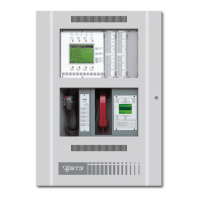System overview
1.26 EST3 Installation and Service Manual
Signature series devices
The Signature series family consists of intelligent smoke and
heat detectors, bases, input/output modules, and ancillary
devices. The EST3 network supports Signature series devices
using several models of the Signature Driver Controller module.
Up to 125 detectors and 125 modules can be connected to the
Signature Data Circuit on these modules.
The Signature series smoke and heat detectors contain their own
microprocessors. This allows the devices to make alarm
decisions based on the information gathered by the sensing
elements incorporated in the device. Signature series detectors
can be installed in any of four detector bases:
• The Standard Base provides wiring terminals for connection
to a remote LED.
• The Relay Base provides a detector activated, pilot-duty dry
contact relay used to control external appliances.
• The Sounder Base incorporates a sounder horn that can be
controlled by the detector, by a special Signature module, by
the control panel, or by programmed rules
• The Isolator Base protects the Signature Data Circuit from
wiring shorts.
Signature modules interface and support the operation of
initiating devices, conventional 2-wire smoke and heat detectors,
manual pull-stations, strobes, bells, etc. The actual functions of
each Signature module is determined by a personality code
downloaded to the module through the System Definition Utility
(SDU) program.
Signature series manual pull-stations (1-stage and 2-stage)
feature an integral Signature module that monitors the station.
One-stage stations are monitored by a single input module that
sends an alarm signal to the loop controller when the station is
activated. Two-stage stations are monitored by a dual input
module which sends two independent alarm events to the control
panel; one when the pull-switch is activated, and the second
when the key switch is activated.
Alarm sensitivity setting
Alarm sensitivity refers to the primary threshold (expressed in
percent smoke obscuration) at which the smoke detector will go
into alarm. The alarm sensitivity setting for smoke detectors can
be set to one of five sensitivity levels. When smoke detectors
having both ionization and photoelectric elements are used, the
sensitivity setting applies to both elements. Reduced sensitivity
settings are used to reduce the occurrence of nuisance alarms.

